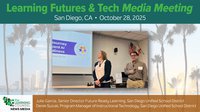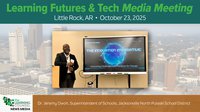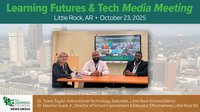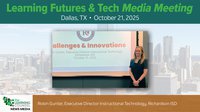Are you wondering yet what AI is going to do for the schooling enterprise? Well, the current Generative AI use by teachers and students and some individual administrators for specific tasks is just the tip of the iceberg with AI.
Learning Counsel Research asked what AI will be doing for administrations, a holistic concept, and immediately formed the Omni-AI Alliance. Please go and join and plan to be in the next virtual meeting to learn more.
Omni-AI is a term for the convergence of multiple types of AI, not just the consumer versions educators are becoming familiar with. Creating an Omni-AI layer holds potentials to solve many intractable problems in teaching and learning, including shifting the underlying assumptions of schooling form, model and teaching methods to create more personalized learning and unburden teaching. It will change the entire way schools are administered today.
Let’s go a little deeper in understanding the next-level of AI in schooling, which is Omni-AI.
When used in the context of an Omni-AI, the term "plasmic mind" refers to a hypothetical
artificial intelligence that exhibits qualities of adaptability and fluidity, potentially blurring the lines between different intelligence and agentry – doing the work smartly. The degree in shift of what the humans will be doing as this comes about can barely be described. It will be as different as night from day.
Adding Omni-AI to school administration would put a new AI Core into place as both an intelligence and agent between and additional to all other systems and resources. A “Core” is like a central platform-of-all-platforms with its own interface.
A "plasmic mind" in a school’s Omni-AI Core would suggest:
In simpler terms, a "plasmic mind" in an Omni-AI would represent a highly flexible and self-evolving intelligence that can adapt and thrive in a wide range of situations, much like a fluid adapts to its container.
To construct a hypothetical Omni-AI Core that serves as a "plasmic AI mind" for a school or district enterprise, schools will soon be building a modular intelligence and orchestration layers —a connective fabric between operational systems (LMS, SIS, HR, Finance, Scheduling) and the growing ecosystem of AI-powered educational apps and services. This hub functions as both:
- Agentry: Active agents that monitor, nudge, schedule, analyze, and personalize in real time.
- Management: Integrative dashboards and backend intelligence coordinating cross-system activities and user interactions.
The Omni-AI Core’s Purpose
Create a living digital intelligence layer across the enterprise that orchestrates, adapts, and evolves every learner’s journey, every staff member’s workload, and every system’s output in a synchronized, AI-enhanced ecosystem. This level of AI would not just respond but also originate action.
In order to achieve this purpose, schools would need to craft their Omni-AI by considering these two things:
1. Governance & Guardrails
- Human Override Rights
- Explainability Layer
- Bias Detection Module
- Opt-in App Consent Flows
2. Outcome Metrics
- Personalized pacing ratio
- Instructional adaptability index
- Staff time optimization score
- Emotional climate trendline
- AI agent accuracy + bias rates
What’s going on in an Omni-AI Core hub? Here is the Learning Counsel’s view of the architecture. There are three main parts.
- Foundational Layers
The foundational layers would necessarily need to include:
Ingestion & Normalization Layer - Purpose: bring raw data into structure, make usable. Includes
ETL pipelines; API data collectors; Data cleaning routines; Schema alignment tools
Structuring & Semantic Layer - Purpose: turn raw data into structured meaningful formats. Includes tagging & classification models (e.g., NLP for labeling); Knowledge graphs – mapping relationships; Ontology Frameworks – rule-based inference, decision trees, logic graphs; Pattern Recognition Core - Abstractive summarizations (transformers, LLMs), Statistical aggregation {mean-median, trend analysis); Prompt-engineered reasoning (few-shot, chain-of-thought).
Sub-Frameworks - Purpose: AI builds specialized engines depending on the task. Examples: a. Pattern Recognition Core Clustering algorithms (K-means, DBSCAN), Dimensionality reduction (PCA, t-SNE), databases, Data Manipulation Language (DML) or CRUD.
Orchestration & Optimization Layer - Purpose: Coordinate AI subcomponents to work toward a defined goal. Includes workflow orchestrators (e.g. Apache Airflow); Agent-based task allocators; Time AI calendaring with holds auto re-bracketing, rearranged individual learner schedule optimization; Natural language generators (text and context output.)
Outcome Simplification & Delivery - Purpose: distill insights, originate info, respond – pass to interface. Visualization modules (charts, dashboards; Natural language translators; notifications; Recommendations systems (ranked or summarized suggestions)
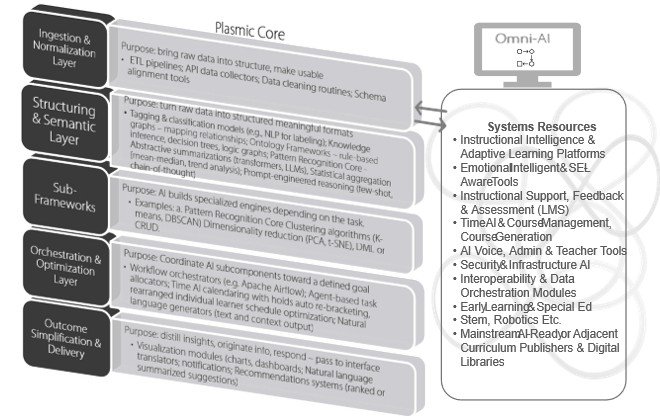
2. Key Core Interoperable Systems
System Integration Role:
- LMS (Canvas, Google Classroom, Toddle App, Knowmadix, Safari Montage, etc.) -- Houses content, assessments, and pacing logic
- SIS (PowerSchool, Infinite Campus, etc.) -- Student records, scheduling, enrollment
- HR & Finance Systems (e.g., Workday) Staff availability, payroll, training deployment
- Scheduling Engine (Knowstory Time AI) -- Orchestrates fractional teacher time, learning cohort intersections, space and time utilization
- Data Lakes & Connectors (Edlink, Authentica, Innive, Schoolday API) -- Normalize and connect siloed data
3. AI App Ecosystem by Function
The following companies represent a cross-section of the growing ecosystem of AI-enhanced platforms that could be ingested into, and managed by, the Omni-AI Hub:
Instructional Intelligence & Adaptive Learning Platforms
- Kiddom – AI-powered courseware delivery and pacing
- Amira – Reading tutor with real-time fluency and comprehension feedback
- DreamBox Learning – Adaptive math platform for K–8 with real-time lesson adjustments
- Carnegie Learning – Combines cognitive science and AI for personalized math and language learning
- MIND Education – Math puzzles that use digital manipulatives without language
- QANDA (Mathpresso) – AI math solver using OCR and math-specific LLM
- Lincoln Learning – Full K–12 courses with AI content bank
- MagicSchool – AI assistant for lesson building
- Knowmadix – AI-powered personalized instruction and support
- Learnetic – Tools such as mAuthor and mCourser with built-in AI design
Emotionally Intelligent & SEL-Aware Tools
- Factors.World – Emotionally intelligent lesson-building platform
- Seamspace – AI-driven SEL tools for classrooms
Instructional Support, Feedback & Assessment
- TeachFX – AI-based classroom dialogue analysis for improving engagement
- Cognii – Conversational AI tutors and essay scoring
- Wooclap – AI for instant quiz, MCQ, and poll generation
- Pressto – AI-supported writing scaffolding with real-time feedback
- Ello – AI reading coach for K–3 with phonics support
- Querium (StepWise AI) – Adaptive math tutor with process-level feedback
- Neurapoints – Metacognitive AI tools that prevent shortcutting and deepen student thinking
- Class Companion, ClassGenius – Personalized learning, skill building, and assessment generation
- CopyLeaks – AI-enabled plagiarism detection
- Curipod – Teacher-created AI-generated interactive lessons
- Colleague.AI – AI-assisted grading, PD recommendations, and lesson creation
Time AI & Course Management
- Knowstory – Dynamic master scheduling, Time AI, and pace-based auto-cohorting
- Zia Learning – AI-powered course and lesson creation
- Kira Learning – AI agents for grading, analytics, and tutoring support
- Learning Genie, Assessprep – Simplified AI assessment and lesson creation
- Toddle App – AI-first LMS with personalized content workflows
AI Voice, Admin, and Teacher Tools
- Merlyn – AI voice assistant for classroom and admin support
- Socrait.AI – Responsible AI tools automating summaries, parent updates, and teacher tasks from classroom verbalization
- Bloomz – Multilingual AI communication tool for families (250 languages)
- Nebula by Makerbot – Monitors student prompt usage, assists grading
- Goodnotes – AI-reimagined note-taking for students
- Kami – AI turns any document into an interactive experience
- LIBSEEN – XR/AI hybrid learning experience builder
Security & Infrastructure AI
- VOLT AI – Real-time AI-driven video surveillance and incident detection
- LiveReach AI – Campus camera AI for security, lecture capture, and conferencing
- Cisco AI Defense – Infrastructure-grade AI for secure storage, networking, and AI operations
- Cybernut – AI-powered security awareness training for staff and students
- Airia.com, BrainFreeze – Customizable AI platforms for end-to-end education solutions
Interoperability & Data Orchestration
- Edlink – API integrations and connectivity between systems
- Innive K12360 – AI-enhanced customizable analytics
- Authentica Solutions – Enterprise data management integration for AI workflows
- Schoolday – API connectors and shared data environments
Early Learning & Special Engagement Tools
- Kibeam – Handheld AI for physical book interaction in early learners
- Lingolet AI – Translation/interpretation AI platform (human/AI hybrid)
STEM & Robotics
- LocoRobo Innovations Inc. – Robotics, AI coding, and STEM learning environments
Mainstream & Traditional Curriculum Resource Publishers (AI-Ready or Adjacent)
These publishers either actively incorporate AI or represent major content bases that the Omni-AI Hub can dynamically align with AI-enhanced delivery systems:
- Amplify, Scholastic, Cengage, IXL Learning, Pearson, Accelerate, Inc., Activate Learning
- Discovery Education, HMH, McGraw Hill, Savvas Learning Company, Stride
- Google, Microsoft – mainstream AI productivity suites embedded in K–12 infrastructure
Here is just one Dynamic Flow Example of what could be achieved with an Omni-AI Core:
“Monday Morning at a Time AI-Enabled School”
- 6:00 AM
– Time AI recalibrates master schedule based on overnight learning data and teacher absences.
– Neurapoints scans for AI shortcuts in some homework passed in; student pacing is recalculated. - 7:30 AM
– Merlyn AI assistant prepares the teacher’s smartboard and digital materials.
– Bloomz pushes a parent update auto-summarizing weekly progress. - 10:00 AM
– Querium adapts a math lesson midstream based on real-time struggle zones.
– Factors.World senses a classroom with high emotional volatility and adjusts the next SEL task. - 10:30 AM
-Socrait.AI summarizes for several teachers the notes from live classes and sends tasks and notifications
- 12:00 PM
– TeachFX logs interactions from morning sessions, providing dashboard feedback on student voice equity. - 3:30 PM
– Colleague.AI generates three optional PD sessions based on teacher’s lesson delivery, gaps noted by Kira’s agent. - 4:00 PM
– Omni-AI Core originates summarized feedback per teacher and per student from all systems, sending notifications as needed to various parties including parents, then reviews real-time efficiency reports generated by the Omni-AI Hub across HR, curriculum completion, and social-emotional health to issue reports to administrators.
Those are just a few of the examples. Thousands more at the level an Omni-AI Core allocating curriculum resources, doing translations to other languages, and more, could be created using the many companies and products already listed.
In a future with plasmic Omni-AI cores, traditional Learning Management Systems (LMSs) would become less central—but not entirely obsolete. Instead, their functions become subsumed into a broader, more intelligent orchestration layer.
Here's why:
What LMSs do today:
- Store and deliver courses
- Track assignments and grades
- Provide communication tools
- Integrate with SIS, content, and assessments
- Facilitate teacher management of learning sequences
In an Omni-AI system:
The Plasmic Omni-AI Core performs the LMS’s functions at any defined level for one student, grouped students, grades, subjects, whole school, compared schools —and dynamically, agentically, and contextually -- plus adds insight from students’ data wallets over time. In other words, it volunteers info like flagging failing curriculum, learners who need extra help, raises alarms about things it found that do not harmonize from one system to another.
The real purpose of an LMS would be course creation to match a school’s brand and that State’s own academic standards and the desired pacing, but as a baseline for the Core to then use adaptively. It’s a repository with some framing.
Retained LMS Features (Recast, not Removed):
- Content repositories will still need to exist but become AI-navigable and modularized into Learning Objects.
- User interfaces may still resemble LMS portals but are more fluid and personalized per role (student, teacher, admin).
- Compliance & reporting layers may require LMS-like data pipelines for external systems (state/federal reporting).
The need for framework systems will remain but will transform. Rather than needing "an LMS" as a single system, schools will need to be asking for a functionally decomposed set of LMS services that plug into the Plasmic Omni-AI core’s orchestration layer.
The same will be true of crafted courses and courseware – the forthcoming Omni-AI Core hubs will not be able to recommend them into pathways unless it can “see” them and will need to see them as content and as the logical workflow of crafted pathways. It is suggested that all curriculum companies create pathway skeletons and tagging schema for Omni-AI.
The implication of schools starting to move in the direction of Omni-AI is that any LMS or course platform and content systems as monoliths are now outdated because of the Generative AI that already exists. Generative AI is already on a trajectory to displace a vast number of edtech offerings, particularly content. It is totally in sync with the way schooling is modeled to leave lesson dominion entirely in the teacher’s hands, stopping at the classroom door with curriculum maps of when academic standards should be taught and letting go of the reins. Teacher authority, imbued with human ego, is naturally gravitating to “build your own” using AI over purchased crafted content full of animation and “science-of” subjects. This is a dangerous thing for institutions because most teachers are not technically instructional designers and most definitely are not digital instructional designers. It’s even more dangerous for a ton of companies.
The best course of action for both schools and edtech providers of systems, apps and repositories is to:
- Rework their system to evolve into AI orchestration-compatible systems, or
- Decompose into microservices, integrating as parts of a larger Plasmic Omni-AI Ecosystem.
Isn’t that interesting? The advice regarding readiness for schools is the same as the advice for edtech providers.
Providers need to be AI-compatible and probably AI-infused. They also need to be compartmentalized with their skeletons and individual organs visible to outside AI – a much larger ask than mapping fields exchange and putting out APIs. This is going to be tricky.
Schools need to be a Omni-AI enterprise and purchase systems ready to plug in. They also need to be able to decompose into microservices, letting themselves remain relevant for whatever parts are of need whether it be teaching, testing, a subject or two, partial affiliation for certain days of the week, letting learning be 24/7 and 365 days of the year.
Everything is about to change.
***





